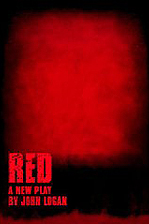Every once in a while I see or read something that really gets under my skin and makes me want to learn more. This happened recently upon seeing a production of the play RED in Atlanta, with Mark Rothko in the center. This is not a review of the play (even though I thoroughly enjoyed it), but some of the things I learned from reading about both the play and Rothko.
RED is a two person play set in the late 1950’s when Rothko was painting his murals for the Four Seasons in New York. If you don’t know this story, Rothko accepted a commission to paint a series of murals for the Four Season’s Restaurant, located in the Seagrams Building on Park Avenue designed by Mies Van Der Rohe and Philip Johnson. Rothko completed 40 paintings, three series in dark red and brown and even altered his horizontal format to vertical to go with the columns, walls, and windows in the restaurant. After a trip to Europe and a visit to the restaurant, he abruptly changed his mind and returned the $35,000 (roughly two million dollars today) he’d been given for the paintings. He kept them in storage until 1968, and they now hang in the Tate Modern in London, a museum in Tokyo, and the National Gallery of Art in Washington D.C.
He never fully explained this decision, but many felt after visiting the restaurant, he found it pretentious and not the best place to view his meditative paintings. He was quoted as saying they would end up in a space “where the richest bastards in New York will come and feed and show off” (told to a Harper’s Bazaar editor).
The play was written by John Logan, who also co-wrote The Gladiator, Rango, and most recently Hugo. After seeing the paintings at the Tate that were intended for the Four Seasons, Logan was inspired to pen the play. He was in London finishing up the screenplay for Sweeney Todd and found “they had a vibrancy, a severe and somber power to them”.
During the play, Rothko quotes Nietzche and Freud He talked about commercialism and how Dali and Picasso would sign menus to make money – even after he had accepted a $35,000 commission.
The play portrayed Rothko as a hard drinker, heavy smoker, and an intellectual with disdain for lesser minds, in short – an egomaniac.
The rectangles floating – often using a palette of red and brown and black – were meant to be seen in a contemplative environment, not on the walls of a restaurant where people went to see and be seen.
Rothko suffered from depression, and ended up committing suicide in 1970. Surprisingly, his suicide coincided to the day the murals arrived at the Tate Modern in London.
I admit to downloading the play and re-reading it later. I wondered how much of the dialogue came from Rothko’s own writings – because his spirit was there. Some of the quotes I remembered and have read in reviews were:
“Selling a painting is like sending a blind child into a room of razor blades” – which showed he had a vulnerable side.
“One day the black will swallow the red.”
The murals are “a continuous narrative, each a new chapter”.
Painting is “10% putting on paint, 90% waiting”.
“You cannot be an artist until you are civilized. You cannot be civilized until you learn.”
In reading about Rothko’s paintings, the word repeated is “pulsates”. As Rothko himself said:
“The fact that people break down and cry when confronted with my pictures shows that I can communicate those basic human emotions…the people who weep before my pictures are having the same religious experience I had when painting them. And if you say you are moved only by their color relationships then you miss the point.”
What have you seen or read lately that inspired you to learn more about the subject or person?
.jpg)
Hi Vickie,
That sounds like a brilliant play. One of the greatest exhibits I've ever seen, ever, is a big Rothko retrospective that came through Paris many years ago. I didn't cry in front of the work, but I was profoundly disturbed by the black paintings he did right before his suicide.
I never pay much attention to the idiosyncrasies in the personalities of artists like Rothko. I read recently that Paul Gauguin, was supposed to be a liar and a dreadful ego freak. Who cares I say. Look at the extraordinary legacy left behind for all of us to enjoy.
Wish I could see “Seeing Red” ! Thanks for sharing your theater/art experience with us.
Andrea
Oops, didn't mean to say I was anonymous up above; This is Andrea from the blog triade. Let me try again.
I just have to laugh – I have been sitting here for a while reading blogs – and I just stumbled upon someone that wrote a blog about Gauguin as a person vs. his art – and then I read your comment where you mentioned gauguin. I would like to see the paintings at the Tate, as well as the church in Houston – that I hear is just beautiful. Thanks for you comment –I enjoyed your last posting too!